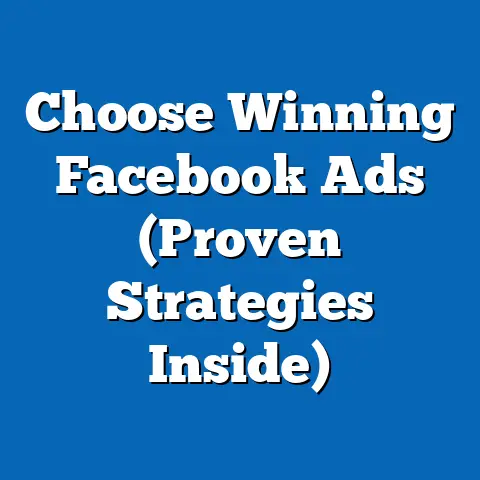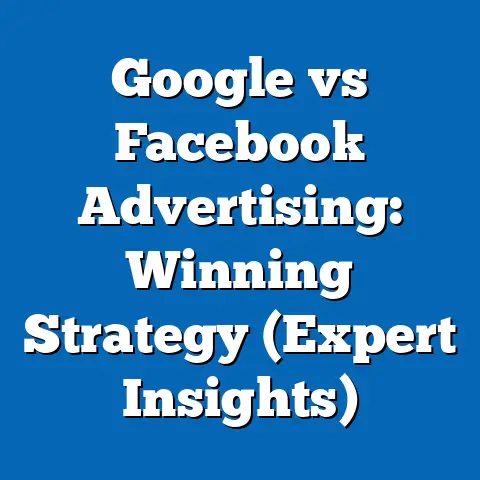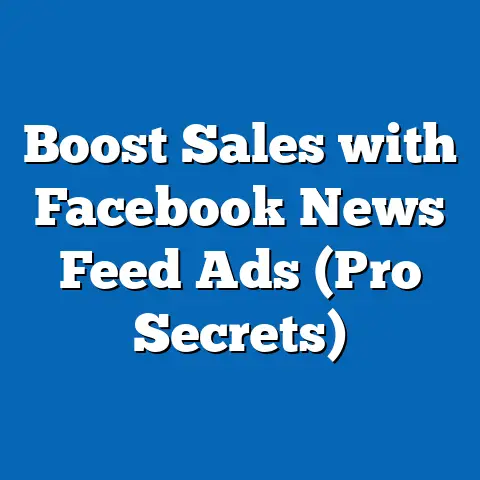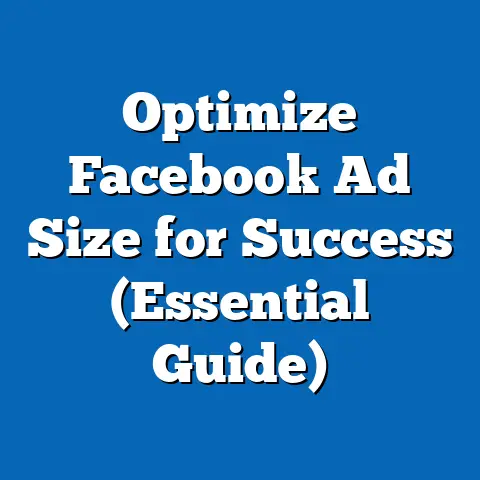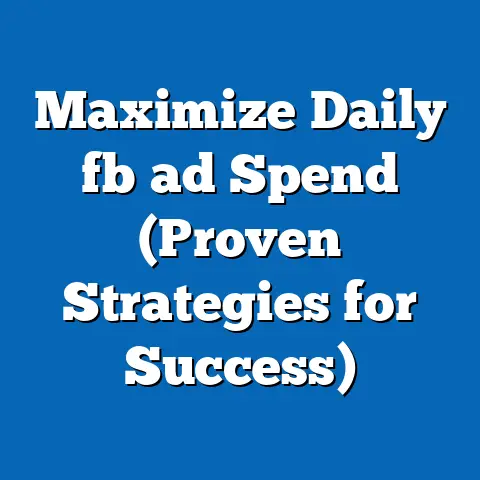Maximize CBD Reach with Facebook Ads (Expert Strategies)
Facebook Ads, in my experience, have always been a fascinating tool. They are incredibly versatile and, once dialed in, require surprisingly little maintenance. This is particularly crucial for businesses in the rapidly growing CBD market. Think about it: you can effectively reach your target audience with minimal ongoing effort, freeing up your time to focus on product development, customer service, and all the other vital aspects of running a business.
What I find most appealing is the accessibility of Facebook’s tools and resources. They’ve made it relatively easy to create, monitor, and optimize ad campaigns, even for those who aren’t necessarily marketing experts. Now, let’s talk about the elephant in the room: the CBD market. It’s booming, no doubt, but it’s also a bit of a minefield when it comes to advertising. That’s where Facebook, with its vast user base and sophisticated targeting options, comes in. It presents a significant opportunity for compliant CBD brands to connect with potential customers.
1: Understanding the CBD Market Landscape
The CBD market is experiencing explosive growth, and it’s essential to grasp the current landscape before diving into advertising. Recent statistics show a consistent upward trend, with projections estimating billions in revenue in the coming years. This growth is fueled by increasing consumer awareness of CBD’s potential benefits and its growing acceptance across various demographics.
However, CBD brands face unique challenges compared to traditional products. Regulatory restrictions are a major hurdle, as advertising guidelines vary significantly across platforms and regions. Public perception also plays a crucial role, as some consumers remain skeptical about CBD due to misconceptions and misinformation. This is why I believe it’s so important to be responsible with marketing your CBD. It’s important to be transparent and educational, and never make medical claims.
Data-driven insights are paramount for understanding potential customers and tailoring advertisements effectively. By analyzing demographic data, consumer preferences, and market trends, CBD brands can identify their target audience and craft messaging that resonates with them. This requires a deep understanding of your customer’s needs, wants, and pain points. I’ve seen firsthand how a well-researched customer persona can dramatically improve ad performance.
Key Takeaway: The CBD market is ripe with opportunity, but success requires navigating regulatory hurdles, understanding consumer perceptions, and leveraging data-driven insights.
2: Setting Up Your Facebook Ads
Setting up your Facebook Ads account correctly is crucial for ensuring compliance with Facebook’s advertising policies for CBD products. This involves carefully reviewing and adhering to Facebook’s guidelines, which prohibit the promotion of illegal or recreational drugs. While CBD is generally legal, it’s essential to avoid making any health claims or promoting products that violate these policies.
Here’s what I recommend:
- Create a Business Manager Account: If you don’t already have one, set up a Facebook Business Manager account. This is the central hub for managing your Facebook pages, ad accounts, and other business assets.
- Link Your Facebook Page: Connect your Facebook page to your Business Manager account.
- Create an Ad Account: Within Business Manager, create a new ad account specifically for your CBD campaigns.
- Set Up Payment Information: Add your payment information to the ad account.
- Review Facebook’s Advertising Policies: This is the most crucial step. Thoroughly review Facebook’s advertising policies, paying close attention to the sections related to health and wellness products. Understand the restrictions and guidelines for promoting CBD products.
Now, let’s get into the campaign setup:
- Selecting Objectives: Choose an appropriate campaign objective that aligns with your marketing goals. Common objectives include brand awareness, website traffic, engagement, and conversions.
- Defining Target Audiences: Define your target audience based on demographics, interests, and behaviors. Facebook offers a wide range of targeting options, allowing you to reach specific segments of the population who are most likely to be interested in CBD products.
- Setting Budgets: Set a budget for your campaign based on your advertising goals and resources. Facebook allows you to set daily or lifetime budgets, giving you control over your spending.
A/B testing is essential for finding the most effective combinations of ad formats, targeting options, and creative content. This involves creating multiple versions of your ads with slight variations and testing them against each other to see which performs best. For example, you could test different headlines, images, or calls-to-action to see which generates the most clicks or conversions. In my experience, even small tweaks can make a big difference in ad performance.
Key Takeaway: Careful setup of your Facebook Ads account and campaigns, combined with thorough A/B testing, is essential for maximizing your reach and achieving your marketing goals.
3: Crafting Compelling Ad Content
Creating compelling ad content is critical for capturing attention and driving engagement in the competitive CBD market. Your ad content should be specifically tailored for the CBD niche, highlighting the benefits of your products while adhering to advertising regulations.
Let’s start with the visuals. High-quality images and videos are essential for capturing attention and conveying brand authenticity. Use visually appealing images that showcase your products in a positive light. Consider using lifestyle imagery that depicts people using your products in everyday situations. Videos can be even more effective, allowing you to demonstrate the benefits of your products and connect with your audience on a deeper level.
The copy is just as important. Your ad copy should be concise, engaging, and informative. Focus on the benefits of your products rather than making medical claims. Use language that resonates with your target audience and addresses their specific needs and pain points. For example, if you’re targeting people who are looking for relief from anxiety, you could highlight the calming and relaxing effects of your CBD products.
I highly recommend you focus on the following:
- Keep it concise: Get straight to the point and highlight the key benefits of your product.
- Use strong verbs: Use action-oriented verbs that encourage people to take action.
- Highlight the benefits: Focus on how your product can improve people’s lives.
- Address pain points: Identify the problems that your target audience is facing and explain how your product can solve them.
- Include a call-to-action: Tell people what you want them to do, such as “Shop Now” or “Learn More.”
The call to action is what drives the sale. Your call-to-action should be clear, concise, and compelling. Tell people exactly what you want them to do, such as “Shop Now,” “Learn More,” or “Get Started.” Make it easy for people to take the next step and engage with your brand.
Here’s an example of successful ad copy that resonates with potential CBD customers:
“Looking for a natural way to relax and unwind? Our premium CBD oil can help you reduce stress, improve sleep, and feel your best. Shop now and experience the benefits of CBD!”
Key Takeaway: Crafting compelling ad content requires high-quality visuals, concise and engaging copy, and a clear call-to-action that resonates with your target audience.
4: Targeting the Right Audience
Facebook offers a wide range of targeting options that allow you to reach specific segments of the population who are most likely to be interested in CBD products. By leveraging these targeting options effectively, you can maximize your reach and generate more leads and sales.
Here are some of the targeting options available on Facebook:
- Demographic Targeting: Target users based on age, gender, location, education, and other demographic factors.
- Interest-Based Targeting: Target users based on their interests, hobbies, and activities.
- Behavioral Targeting: Target users based on their online behavior, such as their purchase history, website visits, and app usage.
- Custom Audiences: Create custom audiences based on your existing customer data, such as email lists or website visitors.
- Lookalike Audiences: Create lookalike audiences based on your custom audiences, targeting users who share similar characteristics and behaviors.
Creating custom audiences and lookalike audiences is essential for reaching users who are most likely to engage with CBD products. Custom audiences allow you to target your existing customers and website visitors, while lookalike audiences allow you to reach new users who share similar characteristics and behaviors. By combining these targeting options, you can create highly targeted ad campaigns that generate significant results.
Facebook’s pixel and conversion tracking can be leveraged to refine audience targeting based on user behavior. The Facebook pixel is a small piece of code that you can install on your website to track user activity. This allows you to see which ads are driving the most traffic and conversions, and to optimize your campaigns accordingly. Conversion tracking allows you to track specific actions that users take on your website, such as purchases or form submissions. This helps you to measure the effectiveness of your campaigns and to identify areas for improvement.
Key Takeaway: Effective audience targeting requires leveraging Facebook’s various targeting options, creating custom and lookalike audiences, and utilizing Facebook’s pixel and conversion tracking to refine your targeting based on user behavior.
5: Optimizing and Analyzing Campaign Performance
Monitoring key performance indicators (KPIs) such as click-through rates (CTR), conversion rates, and return on ad spend (ROAS) is essential for optimizing your ad campaigns and maximizing your return on investment. CTR measures the percentage of people who click on your ad after seeing it. A high CTR indicates that your ad is relevant and engaging to your target audience. Conversion rates measure the percentage of people who take a desired action after clicking on your ad, such as making a purchase or filling out a form. ROAS measures the amount of revenue you generate for every dollar you spend on advertising.
By tracking these KPIs, you can identify areas where your campaigns are performing well and areas where they need improvement. For example, if you have a low CTR, you may need to revise your ad copy or visuals to make them more appealing. If you have a low conversion rate, you may need to improve your website or landing page to make it easier for people to take the desired action. If your ROAS is low, you may need to re-evaluate your targeting or bidding strategy to improve your profitability.
Optimizing ad campaigns based on performance data involves reallocating budgets to high-performing ads and tweaking underperforming elements. This means shifting your budget away from ads that are not generating results and investing more in ads that are performing well. It also means making adjustments to your ad copy, visuals, targeting, and bidding strategy to improve the performance of your underperforming ads.
Ongoing analysis and adjustment are crucial for adapting to changing audience preferences and market conditions. The CBD market is constantly evolving, so it’s important to stay up-to-date on the latest trends and to adapt your campaigns accordingly. This means continuously monitoring your KPIs, testing new ad formats and targeting options, and adjusting your messaging to resonate with your target audience.
Key Takeaway: Continuous monitoring of KPIs, strategic budget reallocation, and ongoing analysis are crucial for optimizing your ad campaigns and adapting to changing audience preferences and market conditions.
Conclusion
In conclusion, maximizing CBD reach with Facebook Ads requires a strategic approach that combines a deep understanding of the CBD market, careful campaign setup, compelling ad content, effective audience targeting, and ongoing optimization. While the CBD market presents unique challenges, the strategic use of Facebook Ads can enable brands to effectively connect with their target audience and drive sales.
I encourage you to take actionable steps towards implementing these expert strategies to enhance your advertising efforts and ultimately drive sales. Start by reviewing Facebook’s advertising policies and ensuring that your ads are compliant. Then, set up your Facebook Ads account and create your first campaign. Experiment with different ad formats, targeting options, and creative content to find what works best for your brand.
Remember, success with Facebook Ads requires patience, persistence, and a willingness to learn and adapt. By following the strategies outlined in this article, you can unlock the immense potential of Facebook advertising and achieve your marketing goals in the CBD market.

